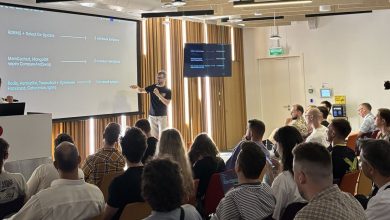
Prashant Bansal transforms how banks operate by bridging traditional financial infrastructure with cutting-edge artificial intelligence. With over 15 years implementing digital banking solutions, he specializes in AI systems that make banking faster, smarter, and more secure.
Bansal’s expertise spans digital banking product development, AI/ML integration, and prompt engineering, which is the discipline that determines whether banking AI systems help or frustrate customers. His work designing fraud detection systems and conversational AI touches millions of banking interactions worldwide.
Bansal explores how AI is reshaping credit decisions and customer service, why prompt engineering is the “hidden force” behind effective banking AI, and what financial institutions must understand about implementing artificial intelligence responsibly. Our discussion offers an insider’s perspective on where digital banking is headed and the invisible AI systems that increasingly power our financial lives.
1. How has the integration of AI and machine learning fundamentally changed the way banks operate during your time in this space, and what surprised you most about this transformation?
Banks and other financial players are already jumping on the AI train, looking to blend their digital platforms with the latest in machine learning, neural networks, and generative AI. A Citigroup report even says AI could boost global banking profits to around $2 trillion by 2028, that is a 9% jump in just five years. An AI-powered bank brings all kinds of perks, from smoother customer service to stronger cybersecurity.
Of course, it’s not all smooth sailing. Regulations, especially in finance, can slow things down a bit, making it tricky to put AI and ML at the very heart of everything. Still, that hasn’t stopped banks from rolling out Gen AI tools in customer service, helping folks get accurate answers almost instantly, with barely any wait time. On the security front, using Gen AI for fraud detection is a total game-changer, especially with how sneaky and advanced phishing attacks have become.
The event which surprises me the most is- adaptability. Given this, financial sector customers now understand the fact that AI is here to stay and they are embracing that fact. In fact, there are certain traditional banks, which now want to move to AI/ML because their customers are now asking for faster turnaround time in everything they perform with their banks.
2. You work at the intersection of traditional banking infrastructure and cutting-edge AI. What does it actually look like when a bank tries to implement AI solutions on top of legacy systems that were built decades ago?
It’s kind of like trying to plug a smart thermostat into a house with 50-year-old wiring. You can make it work, but it takes creativity, patience, and a whole lot of duct tape.
Most banks are still running on core systems that were built way before AI was even a thing. So, when we try to layer AI on top of that, we’re often dealing with messy data, clunky integrations, and processes that weren’t designed to interact with anything “smart.” It’s not like flipping a switch; it’s more like slowly stitching new tech into old fabric without tearing it.
That said, we’re making it happen. A lot of the real magic happens in layers around the legacy systems. We use APIs, cloud-based models, and smart workarounds to get AI doing useful stuff,like answering customer questions, flagging suspicious activity, or helping with credit risk—all without needing to rip out the old core.
It’s not always pretty, but when it works, it’s seriously powerful. The trick is knowing where to start and not trying to reinvent everything at once. Small, high-impact wins—that’s the name of the game.
3. Let’s talk about prompt engineering in banking AI. For those unfamiliar, why is prompt engineering so critical for financial services, and how does it differ from prompting AI in other industries?
As AI keeps transforming the banking and finance world, learning how to talk to these models aka prompt engineering,is becoming a must-have skill. Whether you’re in compliance, fraud detection, customer support, or financial analysis, knowing how to craft the right prompts can seriously boost your efficiency and accuracy.
There are different ways to prompt a model like zero-shot, one-shot, few-shot, or using chain-of-thought techniques. For example, with a few-shot prompt, you can show the model how credit score, debt-to-income ratio, and risk level are related. Give it a couple of examples, and it can start predicting risk scores on its own—super handy when processing credit card applications. This kind of smart prompting helps banks get faster, more accurate results without a ton of manual work.
When it comes to finance, eyebrows are always raised considering the security and safety of money. In other industries, data plays an important role; here it’s both data and money. So, based on what and how you prompt the AI model with, the responses will differ. Without context, prompts will yield to more innovative responses, which sometimes create confusion.
4. You’ve written about AI being “the hidden force” behind effective banking systems. Can you walk us through a real example of how well-designed prompts can make the difference between a helpful banking chatbot and one that frustrates customers?
Absolutely
So imagine you’re chatting with a bank’s support bot because you lost your debit card. You type:“Hey, I lost my card what do I do?”
Now, if the prompt design behind that bot is weak, it might just respond with something super generic like: “Please select from the following options: 1. Lost Card 2. Account Info 3. Talk to Agent”
…which already feels like it’s not listening. Frustrating, right?
But with a well-crafted prompt , one that guides the AI to actually understand the intent and respond like a human would , the bot could say something like: “I’m really sorry to hear that! Let’s get your card blocked right away so your money stays safe. Can you confirm your identity first?”
That feels like help, not a form to fill out.
Behind the scenes, the difference is all about how the prompt was written. Instead of just telling the AI, “Respond to user,” a good prompt might say: “You are a helpful banking assistant. When users mention losing their card, respond with empathy, explain what you’ll do next, and ask for ID verification. Keep it short and friendly.”
That little shift, guiding the AI’s tone, context, and priority, totally changes the experience. It goes from being a robotic FAQ to feeling like someone has your back.
So yeah, in banking (where people are often stressed when they reach out), the prompt is like the personality wiring. Get it right, and the bot becomes a helpful teammate. Get it wrong, and people just want to talk to a human.
5. Banks handle incredibly sensitive financial data. How do you balance the power of AI with the regulatory requirements and compliance challenges that come with financial services?
It’s all about balance and guardrails. On one side, you’ve got AI doing incredible things like spotting fraud in real time, helping customers faster, personalizing services, and automating the boring stuff. On the other side, there are regulations and trust and you absolutely can’t mess those up. If a bank slips, people don’t just lose money, they lose confidence. So how do we handle both? First, there’s a privacy-first mindset. We treat financial data like it’s sacred, and AI systems are built to follow strict rules from the start. Then there’s explainability. It’s not enough for AI to just say “declined,” we need to understand why and be able to explain it clearly. Humans also stay in the loop for critical decisions, because even the smartest models need oversight. Compliance isn’t something we tack on at the end, either; it’s baked into how we train and build these systems, kind of like training a dog from day one on what’s off-limits. And finally, we constantly audit and test these models to make sure they stay accurate, fair, and legal
6. When you’re working with a bank to implement AI-powered fraud detection or risk assessment, what are the biggest misconceptions they have about what AI can and cannot do?
One of the biggest misconceptions banks have when it comes to implementing AI for fraud detection or risk assessment is thinking that AI is some kind of magic box, plug it in, and suddenly fraud disappears, risks are automatically flagged, and everything runs perfectly.
But in reality, AI isn’t magic; it’s math. Powerful, complex math that needs good data, clear goals, and time to get right. A lot of banks expect AI to catch all types of fraud, but what AI really does is find patterns based on the data you give it. If something completely new happens that the model hasn’t seen before, there’s a good chance it’ll miss it unless it’s specifically designed for anomaly detection. Another common misunderstanding is thinking you can just buy an off-the-shelf model and it’ll work right away.
The truth is, every bank’s data, customer behavior, and risk profile is different, so those models usually need tuning and integration before they’re useful. Even when banks say, “we have tons of data,” what we often find is that the data is messy, outdated, or scattered across siloed systems, and AI doesn’t need just any data; it needs the right data: clean, structured, and labeled. Then there’s the belief that once you launch a model, it will just get better on its own over time. That only happens if you actually maintain it, retrain it, monitor it, and build in feedback loops. It’s less like installing software and more like maintaining a garden.
Finally, some people fall into the trap of thinking “if the model says it’s fraud, then it must be,” but that kind of blind trust is risky. AI should support decision-making, not replace it. You still need humans in the loop, especially when the impact of a wrong call is high. At the end of the day, AI can be incredibly powerful, but it’s not plug-and-play.
7. AI can create personalized product recommendations for banking customers – how do you ensure these AI recommendations are actually helpful rather than just pushing products customers don’t need?
Data is the key here; rather, relevant data is the key. Based on the user’s access and activity, the system forms a pattern and feeds that to the AI LLM model. This model then predicts the options that a customer might be interested in, rather than sending numerous marketing emails and pop-ups. These marketing alerts are still in the picture but they are more targeted now instead of random. A user who has a checking account but no credit card, depending on their usage and credit history, the right credit card can be offered upon identifying the user’s usage via their account activity and their spending power.
8. Digital wallets and mobile payments are exploding in popularity. How is AI changing the way these payment systems work behind the scenes, and what role does prompt engineering play in making them smarter?
Digital wallets and mobile payments are blowing up. Everyone’s tapping phones, scanning QR codes, and barely carrying physical wallets anymore. But what most people don’t see is how AI is doing a lot of heavy lifting behind the scenes to make all of this seamless, secure, and smart.
AI is constantly watching payment patterns. It learns how you typically spend, when, where, and how much,and if something feels off (like someone trying to use your wallet from another country at 3 AM), it can instantly flag or block the transaction.AI optimizes everything from identity checks (face scan, fingerprint, etc.) to payment routing, so transactions happen faster and smoother.
Think of prompt engineering as the “language” we use to get AI to work with us more naturally. The better we get at it, the more intuitive these payment systems become.
9. Looking at the current state of banking AI, where do you see the biggest gap between what’s technically possible and what banks are actually implementing? What’s holding them back?
There are quite a few challenges, but if I had to pick the biggest ones, I’d say it’s stuff like outdated tech, messy infrastructure, scattered data all over the place, security risks, and the never-ending maze of compliance.
Most banks are pretty tech-savvy, but when it comes to major changes, there’s usually a bit of hesitation. And honestly, it’s understandable. Big shifts mean dealing with infrastructure overhauls and retraining teams, which is no small task.
Another big issue is how data is handled. If the data’s not well-managed, it’s tough to train large language models properly. That’s when you start getting inaccurate or “hallucinated” answers, which is a NO-NO in banking.
For AI to really deliver value, both banks and their customers need a bit of a mindset shift. And that starts with solid security, smart implementation, and a lot of awareness, especially when we’re talking about anything to do with money or sensitive financial transactions.
10. As someone who works hands-on with banking AI implementations, what emerging trends do you think will define the next decade of AI in financial services? What should we be watching for?
Well, top of my list would be real-time risk and fraud intelligence, followed by embedded finance. Both of these currently exist, too. However, the way the world is getting tech savvy and cyber attacks are getting sophisticated day by day, there is a real need to understand the attacks and systems in real time and mitigate the risk. Financial fraud is something every bank struggles with, and it just takes one occurrence to take the customer’s trust away from their bank or financial institution.
In my view, things we should look forward to include:
- Dynamic credit score evaluation for loan and credit card applications
- Real time fraud detection and not just based on the rules set up in traditional fraud detection systems.
- Smaller banks tapping into AI via Banking-as-a-Service platforms
11. Finally, for other technologists looking to specialize in AI for highly regulated industries like banking, what advice would you give them about navigating both the technical and compliance challenges?
If you’re diving into AI for banking, here’s the deal: it’s not just about building smart models, it’s about building responsible ones. In highly regulated industries like this, you’ve got to think about compliance as much as code. Understand the rules, things like data privacy, explainability, and fairness aren’t optional; they’re the foundation. Don’t treat compliance teams as roadblocks; bring them in early and often. Build with transparency, document everything, and design models that can explain their decisions in plain English. Oh, and remember: working with sensitive data isn’t just cool, it’s a responsibility. The pace might feel slower than in startups, but the impact is deeper. If you can balance trust with tech, you’ll not only build something powerful, you’ll build something that lasts.



